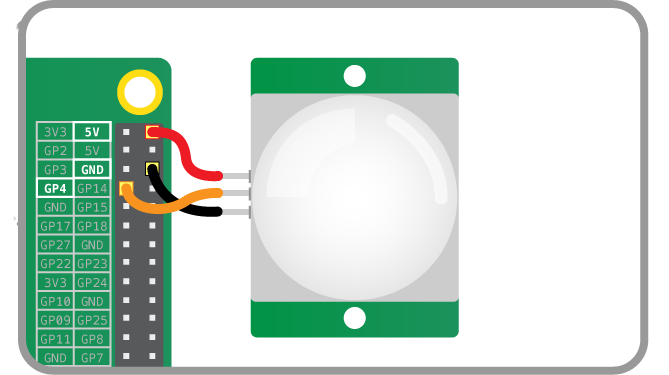6.3 KiB
Input Devices
These input device component interfaces have been provided for simple use of everyday components.
Components must be wired up correctly before used in code.
Note all GPIO pin numbers use BCM numbering. See the notes page for more information.
Button
A physical push button or switch.
Wiring
Connect one side of the button to a ground pin, and the other to any GPIO pin:
Alternatively, connect to 3V3 and to a GPIO, and set pull_up to False when
you create your Button object.
Code
Ensure the Button class is imported at the top of the file:
from gpiozero import Button
Create a Button object by passing in the pin number the button is connected
to:
button = Button(2)
The default behaviour is to set the pull state of the button to up. To
change this behaviour, set the pull_up argument to False when creating your
Button object.
button = Button(pin=2, pull_up=False)
Methods
| Method | Description | Arguments |
|---|---|---|
wait_for_press() |
Halt the program until the button is pressed. | timeout - The number of seconds to wait before proceeding if no event is detected. Default: None |
wait_for_release() |
Halt the program until the button is released. | timeout - The number of seconds to wait before proceeding if no event is detected. Default: None |
Properties
| Property | Description | Type |
|---|---|---|
pin |
The GPIO pin number the button is connected to. | Integer |
is_pressed |
The current state of the pin (True if pressed; otherwise False). |
Boolean |
pull_up |
The pull state of the pin (True if pulled up; False if pulled down). |
Boolean |
when_pressed |
A reference to the function to be called when the button is pressed. | None or Function |
when_released |
A reference to the function to be called when the button is released. | None or Function |
Motion Sensor
A PIR (Passive Infra-Red) motion sensor.
Wiring
Connect the pin labelled VCC to a 5V pin; connect the one labelled GND to
a ground pin; and connect the one labelled OUT to any GPIO pin:
Code
Ensure the MotionSensor class is imported at the top of the file:
from gpiozero import MotionSensor
Create a MotionSensor object by passing in the pin number the sensor is
connected to:
pir = MotionSensor(4)
Methods
| Method | Description | Arguments |
|---|---|---|
wait_for_motion() |
Halt the program until motion is detected. | timeout - The number of seconds to wait before proceeding if no motion is detected. Default: None |
wait_for_no_motion() |
Halt the program until no motion is detected. | timeout - The number of seconds to wait before proceeding if motion is still detected. Default: None |
Properties
| Property | Description | Type |
|---|---|---|
pin |
The GPIO pin number the sensor is connected to. | Integer |
motion_detected |
The current state of the sensor (True if motion is detected; otherwise False). |
Boolean |
when_motion |
A reference to the function to be called when motion is detected. | None or Function |
when_no_motion |
A reference to the function to be called when no motion is detected. | None or Function |
Light Sensor
An LDR (Light Dependent Resistor) Light Sensor.
Wiring
...
Code
Ensure the LightSensor class is imported at the top of the file:
from gpiozero import LightSensor
Create a LightSensor object by passing in the pin number the sensor is
connected to:
light = LightSensor(4)
Methods
| Method | Description | Arguments |
|---|---|---|
wait_for_light() |
Halt the program until light is detected. | timeout - The number of seconds to wait before proceeding if light is not detected. Default: None |
wait_for_dark() |
Halt the program until darkness is detected. | timeout - The number of seconds to wait before proceeding if darkness is not detected. Default: None |
Properties
| Property | Description | Type |
|---|---|---|
pin |
The GPIO pin number the sensor is connected to. | Integer |
light_detected |
The current state of the sensor (True if light; otherwise False). |
Boolean |
when_light |
A reference to the function to be called when light is detected. | None or Function |
when_dark |
A reference to the function to be called when darkness is detected. | None or Function |
Temperature Sensor
One-wire Digital Temperature Sensor.
Wiring
...
Code
Ensure the TemperatureSensor class is imported at the top of the file:
from gpiozero import TemperatureSensor
Create a TemperatureSensor object:
temp = TemperatureSensor()
Methods
...
Properties
| Property | Description | Type |
|---|---|---|
value |
The current temperature reading in degrees Celsius. | Float |
MCP3008 Analogue-to-Digital Converter
MCP3008 ADC (Analogue-to-Digital converter).
The MCP3008 chip provides access to up to 8 analogue inputs, such as potentiometers, and read their values in digital form.
Wiring
...
Code
Ensure the MCP3008 class is imported at the top of the file:
from gpiozero import MCP3008
Create an MCP3008 object:
pot = MCP3008()
Read the value of the device:
print(pot.value)
Alternatively, access an input value with the MCP3008's context manager:
with MCP3008() as pot:
print(pot.value)
It is possible to specify the device and the channel you wish to access.
The previous example used the default value of 0 for each of these. To
specify them, pass them in as arguments:
pot = MCP3008(device=1, channel=7)
MCP3004 Analogue-to-Digital Converter
MCP3004 ADC (Analogue-to-Digital converter).
The MCP3004 chip provides access to up to 4 analogue inputs, such as potentiometers, and read their values in digital form.
The interface is identical to MCP3008.

